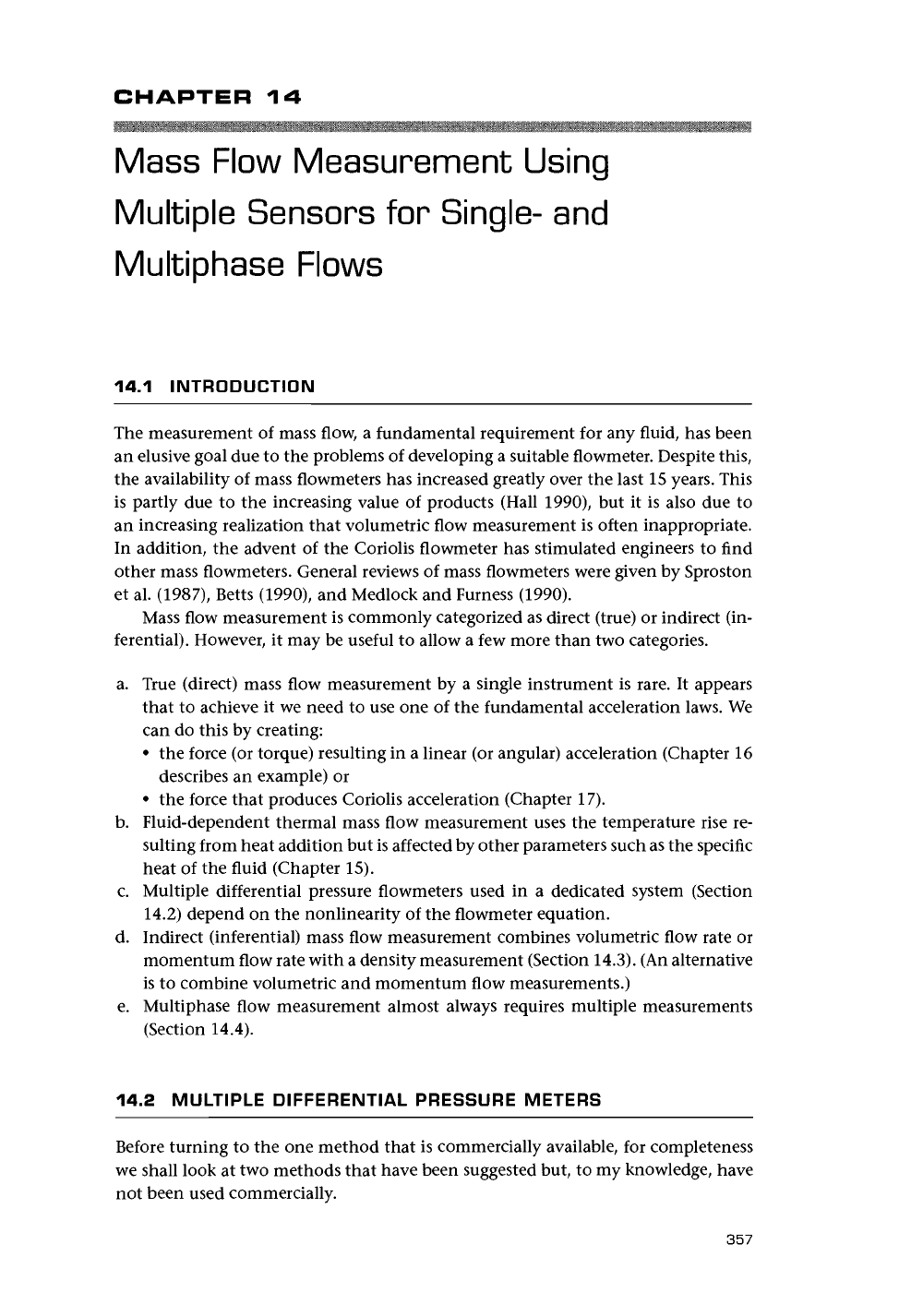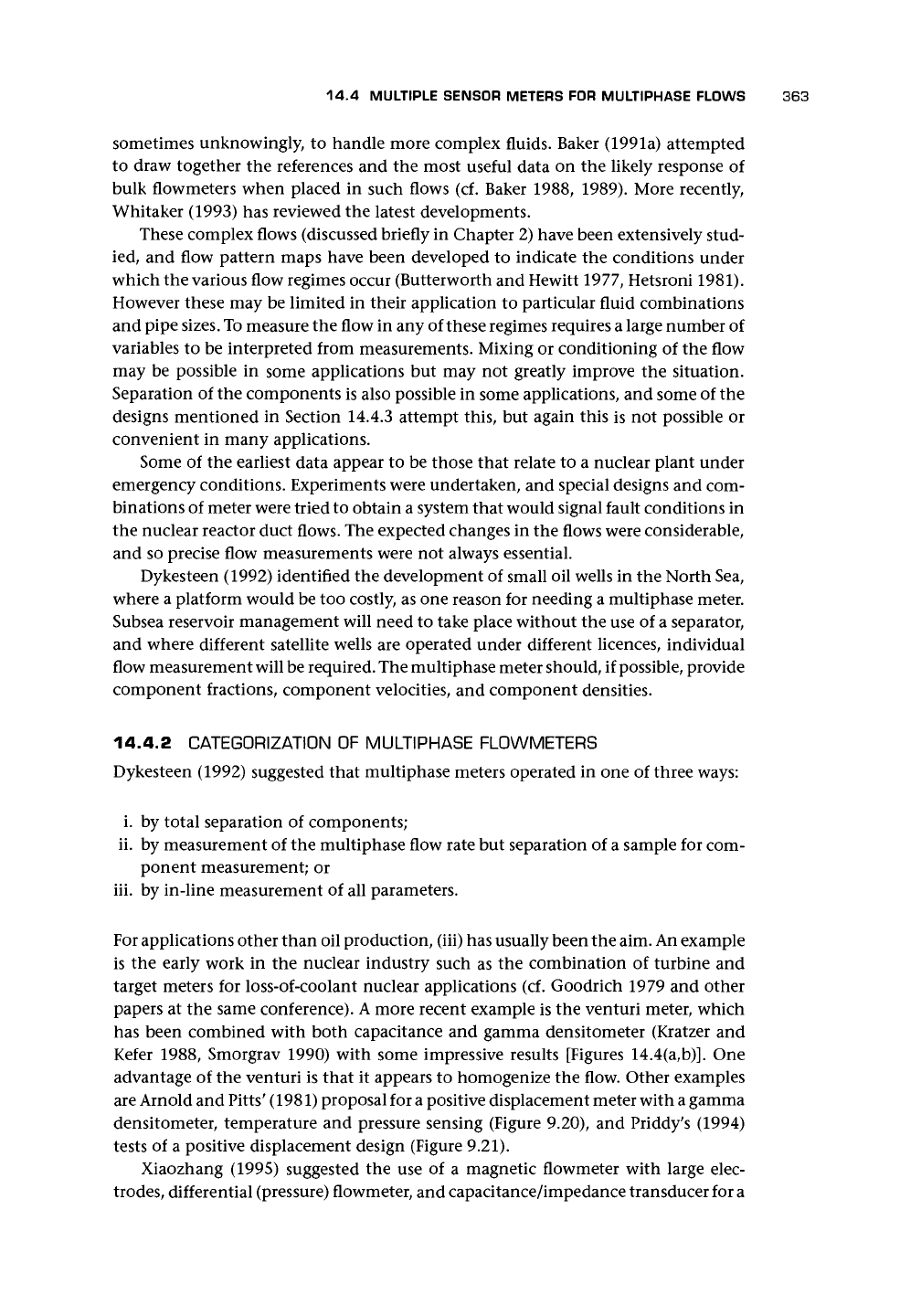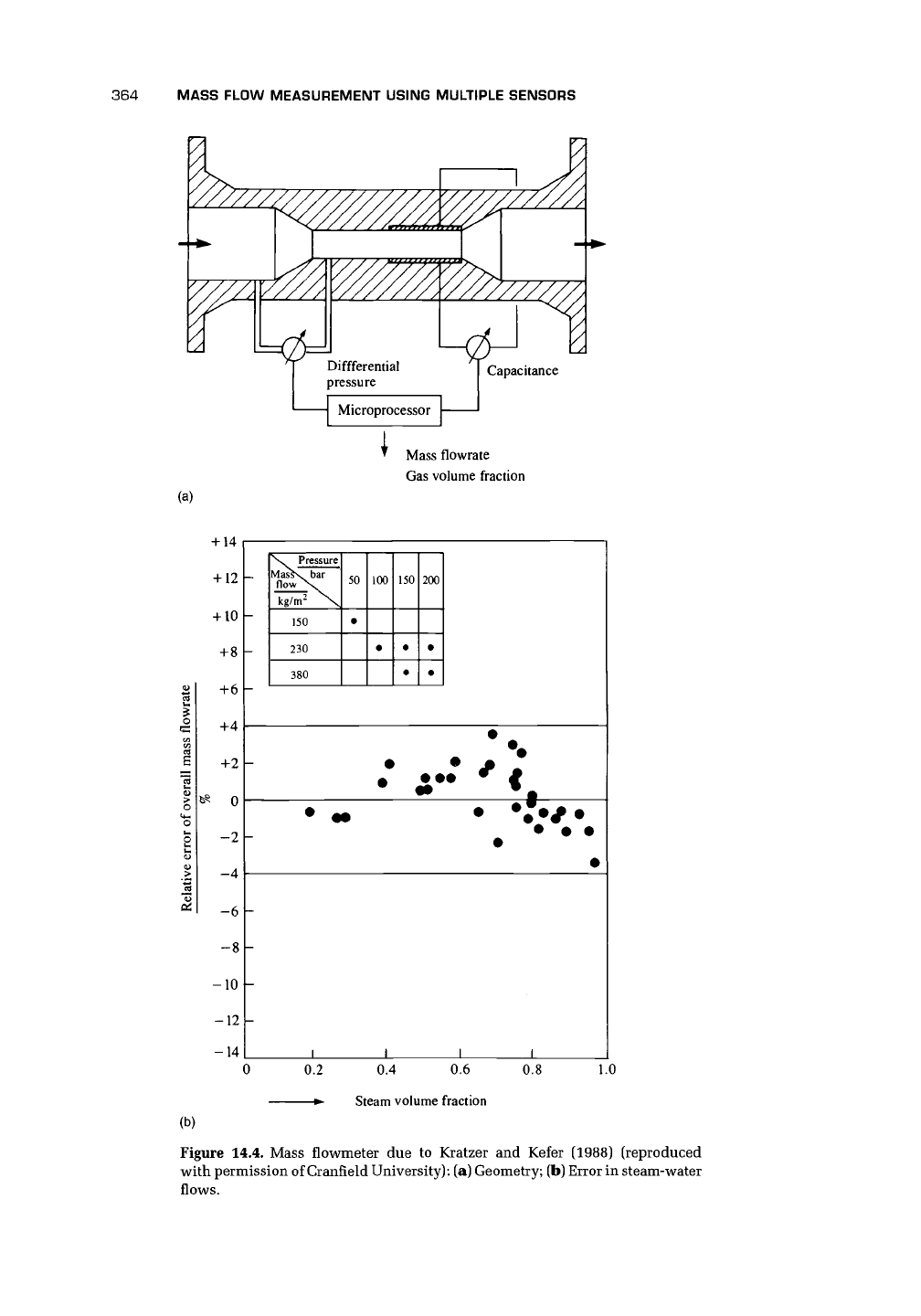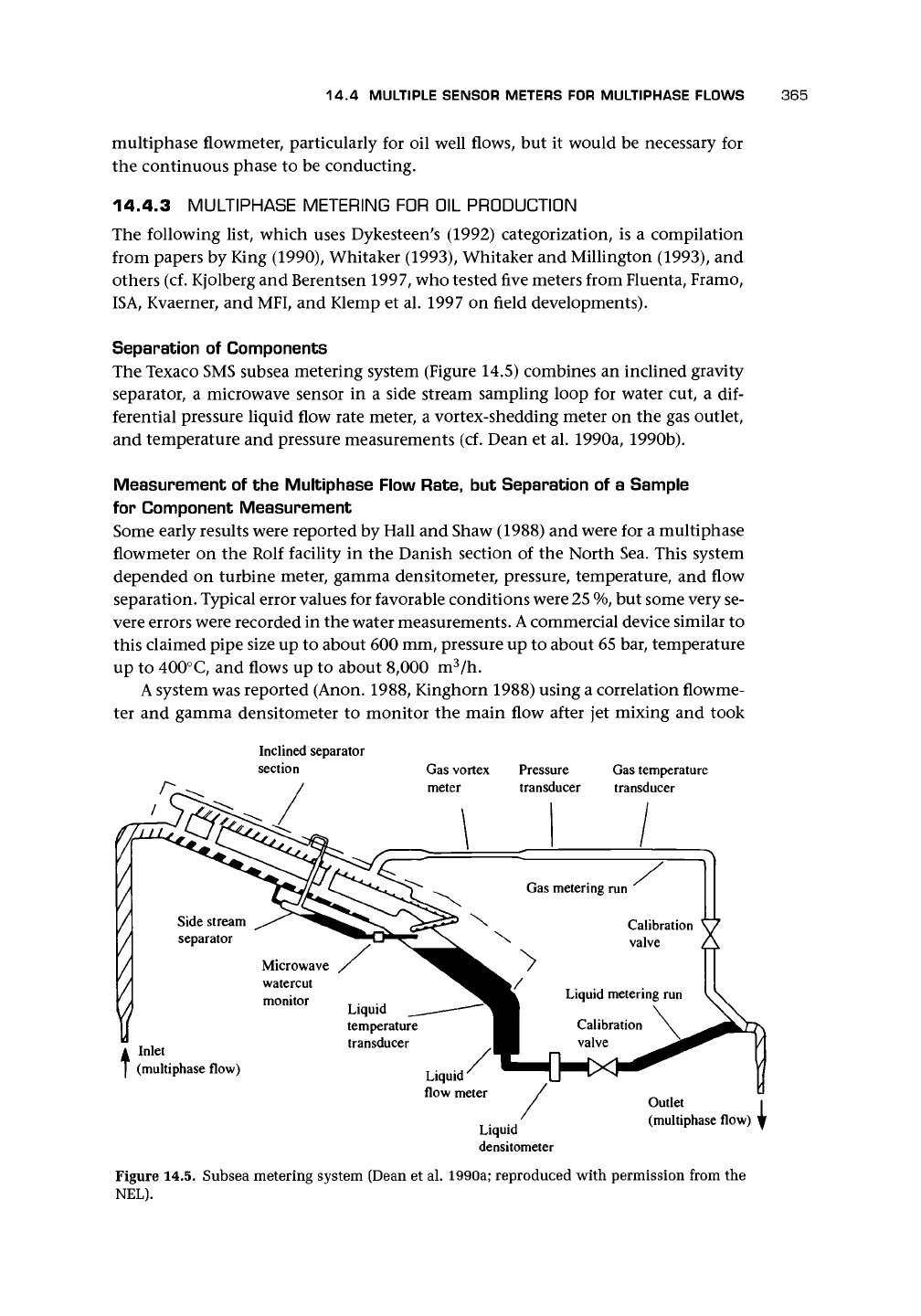Baker R.C. Flow Measurement Handbook: Industrial Designs, Operating Principles, Performance, and Applications
Подождите немного. Документ загружается.


CHAPTER
14
Mass Flow Measurement Using
Multiple Sensors for Single- and
Multiphase Flows
14.1 INTRODUCTION
The measurement of mass flow, a fundamental requirement for any fluid, has been
an elusive goal due to the problems of developing a suitable flowmeter. Despite this,
the availability of mass flowmeters has increased greatly over the last 15 years. This
is partly due to the increasing value of products (Hall 1990), but it is also due to
an increasing realization that volumetric flow measurement is often inappropriate.
In addition, the advent of the Coriolis flowmeter has stimulated engineers to find
other mass flowmeters. General reviews of mass flowmeters were given by Sproston
et al. (1987), Betts (1990), and Medlock and Furness (1990).
Mass flow measurement is commonly categorized as direct (true) or indirect (in-
ferential). However, it may be useful to allow a few more than two categories.
a. True (direct) mass flow measurement by a single instrument is rare. It appears
that to achieve it we need to use one of the fundamental acceleration laws. We
can do this by creating:
• the force (or torque) resulting in a linear (or angular) acceleration (Chapter 16
describes an example) or
• the force that produces Coriolis acceleration (Chapter 17).
b.
Fluid-dependent thermal mass flow measurement uses the temperature rise re-
sulting from heat addition but is affected by other parameters such as the specific
heat of the fluid (Chapter 15).
c. Multiple differential pressure flowmeters used in a dedicated system (Section
14.2) depend on the nonlinearity of the flowmeter equation.
d. Indirect (inferential) mass flow measurement combines volumetric flow rate or
momentum flow rate with a density measurement (Section 14.3). (An alternative
is to combine volumetric and momentum flow measurements.)
e. Multiphase flow measurement almost always requires multiple measurements
(Section 14.4).
14.2 MULTIPLE DIFFERENTIAL PRESSURE METERS
Before turning to the one method that is commercially available, for completeness
we shall look at two methods that have been suggested but, to my knowledge, have
not been used commercially.
357

358 MASS FLOW MEASUREMENT USING MULTIPLE SENSORS
Pump
Figure 14.1. Twin venturi system.
Twin Venturi System
The twin venturi system depends on the use of two identical venturi meters (or
other differential pressure devices) that are arranged in parallel balanced paths as
shown in Figure 14.1. By means of a metering pump, which transfers q
vp
from one
line to the other, the flows may be unbalanced. If the pump is off, so that the flow
is split equally between the two paths and is, therefore, the same in each meter,
the differential pressure across each meter is also the same. If the pump is started,
then one venturi meter has a lesser and the other a greater flow passing through it.
The pressure difference between the throat pressures A/?
A
B is then measured, and the
mass flow rate q
m
is deduced.
We first note that the pressure drop to the throat of each venturi is given by
Ap
A
= Ap
B
= K(q
m
/2)
2
/p (14.1)
where K is a constant, p is the density of the fluid, and q
m
is the total mass flow
through both Venturis, and so q
m
/2 is the total mass flow through one of the Venturis
when the flows are equal.
If the main flow q
m
splits equally, then if the pump is started and transfers fluid
as shown, and provided that the upstream pressures at inlet to the Venturis are not
affected by the transfer, the equation for the pressure drop to the throat of
A
will be
(14.2)
(14.3)
and to the throat of
B
Ap
B
= K(q
m
/2-pq
vp
)
2
/p
Thus the differential pressure will be
= K(q
m
/2 + pqv
V
)
2
/p - K(q
m
/2 - pq
vp
)
2
/p
= K (q^/4 + pq
m
qv
P
+ P
2
<£
p
)/p - K [q^/A - pq
m
q
vp
+
p
2
q
2
p
)/p
= 2Kq
m
q
vp
(14.4)

14.2 MULTIPLE DIFFERENTIAL PRESSURE METERS 359
Hence
Pressure
tappings
qm=^P
L
(14.5)
Thus the precision of q
m
depends on
B,
K the venturi constant assumed to be
the same for each meter, and q
vp
, which is
set by the pump. However, there are clearly
various effects such as the incompressibil-
ity of the fluid and the disturbing effect of
the transfer flow, which would need careful
consideration.
Brand and Ginsel's System
This is illustrated in Figure 14.2. It has
similarities to the twin venturi method.
Rotating
cylinder
Figure 14.2. Brand and Ginsel's system.
The flow on each side of the rotating cylinder passes through a contraction. An
imbalance in the flow
is
introduced by rotating the central cylinder and the pressures
at the contraction throats are again compared.
Medlock (1989) refers to an
MSM1
flowmeter made by Professor Dr.
W.
J. D. van
Dijck and associates at the Technical University of Delft. The MSM1 meter (Massa
Stroon Meter) was | in. and consisted of a solid cylindrical rotor spinning at a
constant angular velocity within the meter casing. The rotor induced circulation,
and so half of the annulus passed more fluid, and the other half passed less. A
differential pressure was established between the two throats in the same way as in
the differential venturi system, and the mass flow rate was found to be proportional
to the differential pressure and the rotational speed.
14.2.1 HYDRAULIC WHEATSTONE BRIDGE METHOD
A Wheatstone bridge system has been successfully developed as a commercial in-
strument.
14.2.2 THEORY OF OPERATION
The theory of operation of this type of flowmeter is illustrated by Figure 14.3. Four
matched orifices are arranged in a hydraulic Wheatstone bridge network with a
constant volume pump producing a recirculating flow. The process mass flow is q
m
,
and the pump volumetric flow is q
Yp
. The pressure drop is given by A/?BD in Figure
14.3(a) for the situation when q
m
> pq
vp
(high flows). If the flow q
m
were to divide
equally between the upper and lower halves of the Wheatstone bridge, then the
pressure drop through each would be [as for Equation (14.1)]
Ap = K(q
m
/2)
2
/p
Applying this relationship to the four orifices in the bridge, when the
pump creates an unbalanced flow, as in Figure 14.3(a), we obtain the following

360 MASS FLOW MEASUREMENT USING MULTIPLE SENSORS
(a) (b)
Figure 14.3. Wheatstone bridge flowmeter:
(a)
High flows;
(b) Low
flows.
expressions:
= K(q
m
/2
+
pq,
P
/2)
2
/p
-
K(q
m
/2
-
pq
yp
/2)
2
/p
Kq,
'vp
(14.6)
(14.7)
(14.8)
(14.9)
Similarly,
for the
case
of
Figure 14.3(b),
the
pressure difference
is
given
by
Ap
AC
when
q
m
<
pq
vp
(low flows),
and we
obtain
Ap
A
c
=
ApAB
+
ApBC
- -K(q
m
/2
-
pq
yv
/2)
2
/p
+
K(q
m
/2
+
pq
vp
/2)
2
/p
(14.10)
(14.11)
(14.12)
^vp
14.2.3 INDUSTRIAL EXPERIENCE
The meter consists
of
four precisely matched orifices forming
the
hydraulic Wheat-
stone bridge. A recirculating pump establishes reference flow
in the
bridge.
At
zero
measured flow rate, pressure drop across
the
bridge
is
zero. As measured flow passes
through the meter,
it
upsets the balance
in
the bridge such that a differential pressure
signal, which
is
linear
and
proportional
to
true mass flow rate,
is
generated.
The resulting flowmeter
is
claimed
to
give true mass flow rate
and
may
be unaf-
fected
by
changes
in
fluid, temperature, density,
and
viscosity.
It can be of
stainless
steel construction
and
capable
of
operation
at
elevated temperatures
and
with
low
lubricating liquids.

14.3 MULTIPLE SENSOR METHODS 361
Typical flow ranges may be
• 0-2.3 kg/h (0-5 lb/h) for microflows with a turndown of 50:1 and a minimum
flow of 0.05 kg/h;
• 0-900 kg/h (0-2,000 lb/h) for low flow ranges and 0.5 kg/h minimum flow for
low ranges; and
• 0-23,000 kg/h (0-50,000 lb/h) for high flow ranges with about 100:1 turndown.
A
wide range version in the low flow range may be capable of 500:1 turndown.
Best accuracy may be of order 0.5% of rate plus 0.02% FSD, and repeatability 0.25%
of rate although in some designs an additional amount based on FSD may be added.
Pressure drop may be in the range from about 0.1 to 2 bar. Depending on the design,
fluid temperature may be in the range from about -18 to +150°C and pressure up
to about 67 bar gauge.
14.2.4 APPLICATIONS
This device is particularly suited for fuel flow measurement applications such as
engine emission control and fuel economy testing. Other applications may be fuel
efficiency testing in boilers. It produces an output signal that is linearly proportional
to mass flow rate.
14.3 MULTIPLE SENSOR METHODS
If the fluid has unknown properties, we shall probably need to combine the flow
measurement with a density measurement. However, if the fluid has known param-
eters,
we may be able to use equations that describe the fluid's state. The following
are examples of both.
•
A
volumetric meter (e.g., turbine) with density, or pressure and temperature mea-
surement. This is a relatively common practice. A combination of electromag-
netic flowmeter with a gamma density-sensing cell has been available commer-
cially. The mass flow will be given by
qm
= pVA (14.13)
where p is the fluid density, V is the mean velocity through the meter, and A is
the cross-section of the meter. There is likely to be a correct position at which to
measure the density. There will, therefore, be an overall uncertainty stemming
from the various components
q
m
p V A
or the equivalent root-mean-square expression. Similar error calculations will be
appropriate to the other methods mentioned here.
•
A
vortex meter that combines frequency measurement with measurement of lift
on the shedding
body.
Itoh and Ohki (1993) claim
a
vortex flowmeter design that
obtains mass flow rate by the use of the lift on the central body divided by the

362 MASS FLOW MEASUREMENT USING MULTIPLE SENSORS
frequency of pulsation. This depends on the assumption that the lift coefficient
and the Strouhal number are both constant, so that the lift is proportional to
p
V
2
, and the frequency is proportional to V. As a result, the ratio is proportional
to pV.
• Ultrasonic flowmeters. The speed of sound is related to the density
c
2
= yp/p (14.15)
where y is the ratio of the specific heats, and p is the density of the fluid. A
similar equation for liquids is
c
2
=
l/(k
sP
)
(14.16)
where k
s
is the adiabatic compressibility. Because c
2
appears in the equation for
time-of-flight ultrasonic meters, it can be combined through these equations to
give velocity times density and hence mass flow. This assumes that for gases y
is constant, which is a good approximation for air. The value of y is dependent
on the number of atoms in the gas molecule. The value of p will be needed. For
a liquid, the value of k
s
will be needed (Baker 1976).
• Alternatively for ultrasonic flowmeters the impedance of the fluid is related to
the density and may be used to obtain its value (Guilbert and Sanderson 1996a).
• A differential pressure flowmeter with the density of the fluid obtained ei-
ther directly or, say, for a gas via pressure and temperature measurements (cf.
Figure 5.20).
• A combination of velocity measurement to obtain V, with momentum pV
2
,
allows the value of
p
V to be found.
Medlock used the term hybrid (1989) to describe meters combining momen-
tum sensing and volume sensing, such as the venturi tube with an electromagnetic
flowmeter built into it or venturi and turbine meters (Frank et al. 1977, Reimann et
al.
1982) or the turbine meter that also senses drag on the wheel or on a separate
drag plate (Reimann et al. 1982) or gauze (Cole 1985). Wong et al. (1981) suggested
the use of the pressure drop in a swirl generator in combination with a venturi.
14.4 MULTIPLE SENSOR METERS FOR MULTIPHASE FLOWS
14.4.1 BACKGROUND
There is a growing need to measure the flow of fluids, which consist of more than
one component. The nature of the second component may or may not be known,
and the proportions or indeed the existence of the second or even third component
may not be known. The reasons for this growing need are the increasing value of
such fluids, being used in an ever widening variety of processes, and the increasing
requirement to conserve energy. The fluids involved range across wide industry areas
as diverse as food processing and subsea hydrocarbon extraction, but at present the
technology appears mainly to be driven by the latter.
Against this background, most flowmeters have been designed to measure the
single-phase flow of a Newtonian fluid but, despite this, are being called on,

14.4 MULTIPLE SENSOR METERS FOR MULTIPHASE FLOWS 363
sometimes unknowingly, to handle more complex fluids. Baker (1991a) attempted
to draw together the references and the most useful data on the likely response of
bulk flowmeters when placed in such flows (cf. Baker 1988, 1989). More recently,
Whitaker (1993) has reviewed the latest developments.
These complex flows (discussed briefly in Chapter 2) have been extensively stud-
ied, and flow pattern maps have been developed to indicate the conditions under
which the various flow regimes occur (Butterworth and Hewitt 1977, Hetsroni 1981).
However these may be limited in their application to particular fluid combinations
and pipe
sizes.
To measure the flow in any of these regimes requires a large number of
variables to be interpreted from measurements. Mixing or conditioning of the flow
may be possible in some applications but may not greatly improve the situation.
Separation of the components is also possible in some applications, and some of the
designs mentioned in Section 14.4.3 attempt this, but again this is not possible or
convenient in many applications.
Some of the earliest data appear to be those that relate to a nuclear plant under
emergency conditions. Experiments were undertaken, and special designs and com-
binations of meter were tried to obtain a system that would signal fault conditions in
the nuclear reactor duct flows. The expected changes in the flows were considerable,
and so precise flow measurements were not always essential.
Dykesteen (1992) identified the development of small oil wells in the North Sea,
where a platform would be too costly, as one reason for needing a multiphase meter.
Subsea reservoir management will need to take place without the use of a separator,
and where different satellite wells are operated under different licences, individual
flow measurement will be required. The multiphase meter should, if
possible,
provide
component fractions, component velocities, and component densities.
14.4.2 CATEGORIZATION OF MULTIPHASE FLOWMETERS
Dykesteen (1992) suggested that multiphase meters operated in one of three ways:
i. by total separation of components;
ii.
by measurement of the multiphase flow rate but separation of a sample for com-
ponent measurement; or
iii.
by in-line measurement of all parameters.
For applications other than oil production, (iii) has usually been the aim. An example
is the early work in the nuclear industry such as the combination of turbine and
target meters for loss-of-coolant nuclear applications (cf. Goodrich 1979 and other
papers at the same conference). A more recent example is the venturi meter, which
has been combined with both capacitance and gamma densitometer (Kratzer and
Kefer 1988, Smorgrav 1990) with some impressive results [Figures 14.4(a,b)]. One
advantage of the venturi is that it appears to homogenize the flow. Other examples
are Arnold and Pitts' (1981) proposal for a positive displacement meter with a gamma
densitometer, temperature and pressure sensing (Figure 9.20), and Priddy's (1994)
tests of a positive displacement design (Figure 9.21).
Xiaozhang (1995) suggested the use of a magnetic flowmeter with large elec-
trodes, differential (pressure) flowmeter, and capacitance/impedance transducer for a

364
MASS FLOW MEASUREMENT USING MULTIPLE SENSORS
(a)
+ 14
+ 12
+ 10
+ 8
+6
+4
+2
t$ 0
2
-4
-6
-8
-10
-12
-14
(b)
Mass flowrate
Gas volume fraction
-
—
_
N^
Pressure
MasSv bar
flow \
kg/m
2
^^
150
230
380
50
•
-
• ••
1
1 1 1
100
•
150
•
•
200
•
•
•* ••• * <
f
•
•
1 1 1
0.2 0.4 0.6
» Steam volume fraction
0.8
1.0
Figure 14.4. Mass flowmeter due to Kratzer and Kefer (1988) (reproduced
with permission of Cranfield
University):
(a) Geometry; (b) Error in steam-water
flows.

14.4 MULTIPLE SENSOR METERS FOR MULTIPHASE FLOWS
365
multiphase flowmeter, particularly for oil well flows, but it would be necessary for
the continuous phase to be conducting.
14.4.3 MULTIPHASE METERING FOR OIL PRODUCTION
The following list, which uses Dykesteen
;
s (1992) categorization, is a compilation
from papers by King (1990), Whitaker (1993), Whitaker and Millington (1993), and
others (cf. Kjolberg and Berentsen 1997, who tested five meters from Fluenta, Framo,
ISA, Kvaerner, and MFI, and Klemp et al. 1997 on field developments).
Separation of Components
The Texaco SMS subsea metering system (Figure 14.5) combines an inclined gravity
separator, a microwave sensor in a side stream sampling loop for water cut, a dif-
ferential pressure liquid flow rate meter, a vortex-shedding meter on the gas outlet,
and temperature and pressure measurements (cf. Dean et al. 1990a, 1990b).
Measurement of the Multiphase Flow Rate, but Separation of a Sample
for Component Measurement
Some early results were reported by Hall and Shaw (1988) and were for a multiphase
flowmeter on the Rolf facility in the Danish section of the North Sea. This system
depended on turbine meter, gamma densitometer, pressure, temperature, and flow
separation. Typical error values for favorable conditions were 25 %, but some very se-
vere errors were recorded in the water measurements.
A
commercial device similar to
this claimed pipe size up to about 600 mm, pressure up to about 65 bar, temperature
up to 400°C, and flows up to about
8,000
m
3
/h.
A
system was reported (Anon. 1988, Kinghorn 1988) using a correlation flowme-
ter and gamma densitometer to monitor the main flow after jet mixing and took
Inclined separator
section
Pressure
transducer
Gas temperature
transducer
Liquid
densitometer
Outlet
(multiphase flow)
Figure 14.5. Subsea metering system (Dean et al. 1990a; reproduced with permission from the
NEL).

366 MASS FLOW MEASUREMENT USING MULTIPLE SENSORS
a sample of the flow, separated the liquid and gas components in the sample and
measured the water content of the liquid component (cf. King 1988; Millington and
King 1988, who used a jet mixer/turbine meter package).
S. G. S. Redwood (published reports appear to associate this development with
NEL and Imperial College, London, England) used a static mixer, with venturi or
pressure loss across the mixer, for total flow
rate.
Density
was
obtained with a gamma
densitometer at the venturi throat. In addition, a small sample of the mixture was
extracted and separated, and a Coriolis meter was used to obtain the water cut (Anon.
1994).
King (1988) also mentioned the use of ultrasonic cross correlation (cf. Sidney
et al. 1988a, 1988b).
Tuss (1996) described tests of an Agar multiphase meter consisting of a positive
displacement meter to measure the total volume of the flowing stream,
a
venturi tube
to measure gas liquid flow rates, and a water cut monitor to measure water-liquid
fraction. A gas bypass loop measures the gas volume flow. About 10% uncertainty
of the reading for each component appears to be claimed.
In-Line Measurement of All Parameters
Fluenta, with work from the Christian Michelson Institute (Dykesteen et al. 1985),
developed a meter. It obtained the velocity from cross correlation of signals from
spaced capacitance sensors and used these sensors with gamma densitometer to
obtain the makeup of the fluid. The velocities of all the components were assumed
to be equal (cf. Frantzen and Dykesteen 1990). The Fluenta MPFM 900 is a full-
bore,
noninvasive instrument using capacitance to determine the water cut and the
addition of gamma ray absorption to obtain phase fractions (Millington et al. 1993).
The flow rates are obtained from cross correlation of the axially spaced capacitance
sensors with measures of large and small bubble transits.
Torkildsen and Hanssen (1996) described the Framo meter as consisting of
• static flow mixer for homogenizing the flow;
• multi energy gamma meter for measurement of the oil, water, and gas fractions;
and
• venturi meter for measurement of the total flow with differential pressure, pres-
sure,
and temperature transmitters.
Torkildsen et al. (1997) commented on the need to be aware of the possibility
that flow regime and salinity may affect the meter performance.
The ISA Controls/BP meter (Priddy 1994) (Figure 9.21) uses a twin helical screw
positive displacement meter with gamma density meter spanning the flow between
the two sets of screws.
The CSIRO, Australia, developed a multiphase meter based on gamma rays to
obtain mass, cross correlation of gammas to obtain velocity and dual-energy gam-
mas to obtain mass fraction of oil in liquid. In addition, pressure and temperature
measurements were made, and specific
gravities,
etc., of the components were known
(Watt 1993).
A
measurement uncertainty of between 5 and 9% appears to have been
achieved.
